Themed collection Molecular Magnetism themed collection

Nanoscopic molecular magnets
This review highlights fundamental concepts and synthetic strategies of SMMs and selected examples of 3d, 4f, 5f and mixed 3d–4f, 4d–5d and 3d–5f based SMMs are discussed.

Inorg. Chem. Front., 2015,2, 687-712
https://doi.org/10.1039/C5QI00059A
Theoretical evaluation of lanthanide binding tags as biomolecular handles for the organization of single ion magnets and spin qubits
A newly developed extension to the SIMPRE program allowed the estimation of the potential of 63 polypeptide-coordinated lanthanide structures as single ion magnets and as spin qubits.

Inorg. Chem. Front., 2016,3, 61-66
https://doi.org/10.1039/C5QI00127G
Magnetic and photo-physical investigations into DyIII and YbIII complexes involving tetrathiafulvalene ligand
Three TTF-based complexes have been elaborated using β-diketonate DyIII and YbIII precursors. [Yb(tta)3(L)]·2CH2Cl2 enlarges the scarce series of redox-active luminescent single-molecule magnets with correlation between emissive and magnetic properties.
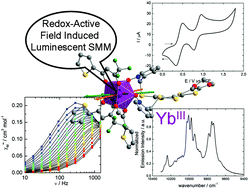
Inorg. Chem. Front., 2015,2, 1105-1117
https://doi.org/10.1039/C5QI00087D
A thioether-decorated {Mn11Tb4} coordination cluster with slow magnetic relaxation
A {MnIII11TbIII4}-nuclearity coordination complex with structurally exposed thioether functional groups and antiferromagnetic intramolecular coupling interactions was synthesised and characterised by temperature- and field-dependent magnetic susceptibility measurements.
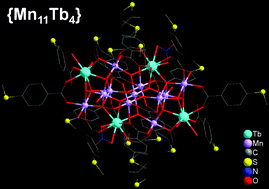
Inorg. Chem. Front., 2015,2, 1095-1100
https://doi.org/10.1039/C5QI00172B
A family of fourteen soluble stable macrocyclic [NiII3LnIII] heterometallic 3d–4f complexes
Fourteen macrocyclic NiII3LnIII (Ln = La, Ce, Pr, Nd, Sm, Eu, Gd, Tb, Dy, Ho, Er, Tm, Yb or Lu) complexes were made, and checked for Single-Molecule Magnet behaviour; two acyclic analogues were structurally characterised.
![Graphical abstract: A family of fourteen soluble stable macrocyclic [NiII3LnIII] heterometallic 3d–4f complexes](/en/Image/Get?imageInfo.ImageType=GA&imageInfo.ImageIdentifier.ManuscriptID=C5QI00130G&imageInfo.ImageIdentifier.Year=2015)
Inorg. Chem. Front., 2015,2, 982-990
https://doi.org/10.1039/C5QI00130G
‘All three-in-one’: ferromagnetic interactions, single-molecule magnetism and magnetocaloric properties in a new family of [Cu4Ln] (LnIII = Gd, Tb, Dy) clusters
A new family of [Cu4Ln] clusters with a ‘propeller’-like topology was obtained; all complexes are ferromagnetically-coupled and display either MCE or SMM properties.
![Graphical abstract: ‘All three-in-one’: ferromagnetic interactions, single-molecule magnetism and magnetocaloric properties in a new family of [Cu4Ln] (LnIII = Gd, Tb, Dy) clusters](/en/Image/Get?imageInfo.ImageType=GA&imageInfo.ImageIdentifier.ManuscriptID=C5QI00146C&imageInfo.ImageIdentifier.Year=2015)
Inorg. Chem. Front., 2015,2, 945-948
https://doi.org/10.1039/C5QI00146C
Molecular spin qubits based on lanthanide ions encapsulated in cubic polyoxopalladates: design criteria to enhance quantum coherence
Axial compression and a magnetic field can help to get coherent spin qubits.
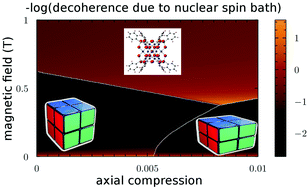
Inorg. Chem. Front., 2015,2, 893-897
https://doi.org/10.1039/C5QI00142K
Magnetic ordering in TCNQ-based metal–organic frameworks with host–guest interactions
Host–guest interactions between the TCNQ-based MOF and aromatic molecules have been found to modulate spontaneous magnetization behavior at low temperatures.
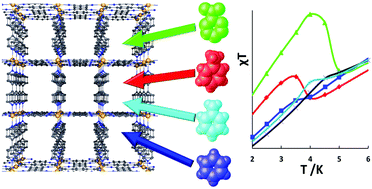
Inorg. Chem. Front., 2015,2, 904-911
https://doi.org/10.1039/C5QI00128E
Diazopyridine–Ni(II) complexes exhibiting intra-chain ferromagnetic interaction after irradiation: formation of magnetic gel
The gel of a diazopyridine–Ni(II) complex in EtOH–20% CH2Cl2 solution showed the magnetic behavior of a ferromagnetic chain with the correlation length of 5–6 units after irradiation, suggesting the formation of magnetic gel.
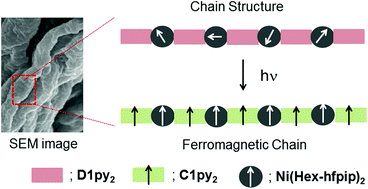
Inorg. Chem. Front., 2015,2, 917-926
https://doi.org/10.1039/C5QI00109A
Graphene oxide and reduced graphene oxide hybrids with spin crossover iron(III) complexes
Graphene oxide and reduced graphene oxide hybrids with spin crossover complexes show the coexistence of electron conduction and unique magnetic behaviors.
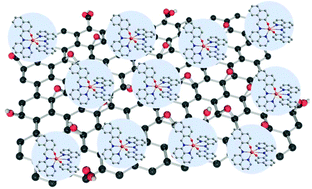
Inorg. Chem. Front., 2015,2, 886-892
https://doi.org/10.1039/C5QI00097A
Structural and magnetic tuning from a field-induced single-ion magnet to a single-chain magnet by anions
By choosing different anions, a mononuclear field-induced single-ion magnet and a one-dimensional single-chain magnet were selectively prepared and characterized.
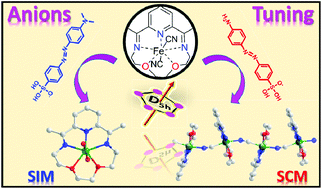
Inorg. Chem. Front., 2015,2, 846-853
https://doi.org/10.1039/C5QI00089K
Single-molecule magnetism in {CoIII2DyIII2}-amine-polyalcohol-acetylacetonate complexes: effects of ligand replacement at the DyIII sites on the dynamics of magnetic relaxation
The article describes the structures, magnetism and ab initio theory of three new “butterfly” {CoIII2DyIII2(OH)2} clusters containing alcoholamine ligands and six bidentate acetylacetonate ligands, per cluster.

Inorg. Chem. Front., 2015,2, 867-875
https://doi.org/10.1039/C5QI00076A
Transition from isolated to interacting copper(II) pairs in extended lattices evaluated by single crystal EPR spectroscopy
Single crystal EPR experiments in copper-doped dimeric Zn(tda)(phen) allowed determination of Cu(II) g- and A-matrices and ZFS parameters, which are used to evaluate the interdimeric exchange interaction in pure Cu(tda)(phen).
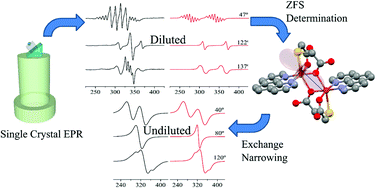
Inorg. Chem. Front., 2015,2, 837-845
https://doi.org/10.1039/C5QI00086F
Single-molecule magnet involving strong exchange coupling in terbium(III) complex with 2,2′-bipyridin-6-yl tert-butyl nitroxide
Intramolecular antiferromagnetic interaction in Tb-6bpyNO was confirmed by comparison with the magnetic properties of Tb-6bpyCO and Y-6bpyNO. Tb-6bpyNO showed a hysteresis loop below 1.6 K, but Tb-6bpyCO did not behave as a single-molecule magnet.

Inorg. Chem. Front., 2015,2, 860-866
https://doi.org/10.1039/C5QI00098J
Chiral biomolecule based dodecanuclear dysprosium(III)–copper(II) clusters: structural analyses and magnetic properties
Biomolecule pyroglutamic acid has been proficiently harnessed for synthesizing a family of three isostructural M4Cu8 dodecanuclear symmetric clusters, which after structural characterization were subjected to magnetic analyses.
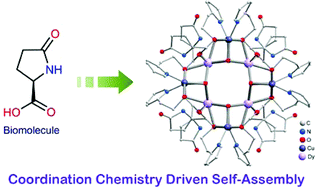
Inorg. Chem. Front., 2015,2, 854-859
https://doi.org/10.1039/C5QI00090D
Azacyclo-auxiliary ligand-tuned SMMs of dibenzoylmethane Dy(III) complexes
A series of eight-coordinate β-diketone mononuclear dysprosium complexes exhibit field-induced SMM properties which can be tuned by the azacyclo-auxiliary ligands, showing different relaxation modes.
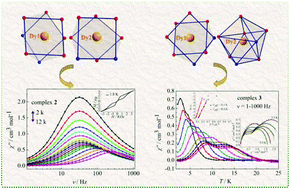
Inorg. Chem. Front., 2015,2, 827-836
https://doi.org/10.1039/C5QI00079C
DFT and TD-DFT studies of electronic structures and one-electron excitation states of a cyanide-bridged molecular square complex
The electronic structures and physical properties of [Co2Fe2(CN)6(tp*)2(dtbbpy)4](PF6)2·2MeOH are investigated by DFT and TD-DFT calculations.
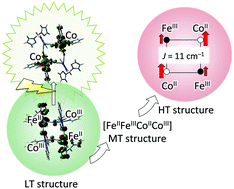
Inorg. Chem. Front., 2015,2, 771-779
https://doi.org/10.1039/C5QI00091B
Synthesis, structure, and magnetic properties of dicopper and tricobalt complexes based on N-(2-pyridylmethyl)iminodiethanol
A novel unsymmetrical dinuclear copper complex [Cu(H2pmide)(NO3)Cu(Hpmide)](NO3)2 (1) and a mixed-valence trinuclear cobalt compound [(pmide)2Co3(CH3CO2)2(NCS)2]·4CH3OH (2) have been prepared and characterized using structure and molecular magnetism.
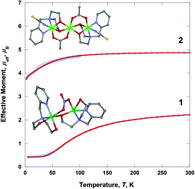
Inorg. Chem. Front., 2015,2, 763-770
https://doi.org/10.1039/C5QI00088B
Iron(II) complexes of 4-sulfanyl-, 4-sulfinyl- and 4-sulfonyl-2,6-dipyrazolylpyridine ligands. A subtle interplay between spin-crossover and crystallographic phase changes
The compound shown exhibits an abrupt thermal spin-transition, with an accompanying crystallographic phase change at slightly lower temperature which is visible as a shoulder on the susceptibility curve.
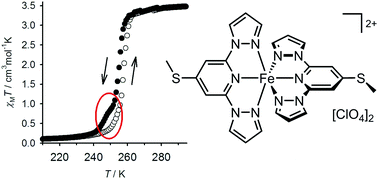
Inorg. Chem. Front., 2015,2, 662-670
https://doi.org/10.1039/C5QI00083A
Syntheses, structures and magnetism of mixed-valence Mn19 and Mn21 complexes supported by alkylamine-based alkoxo-bridging ligands
Two high-nuclearity mixed-valence Mn clusters, Mn19 and Mn21, were synthesised utilizing an alkylamine-based flexible ligand and their magnetic properties investigated.
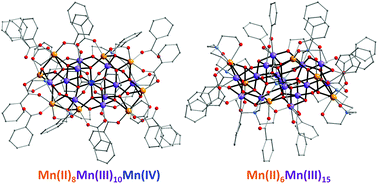
Inorg. Chem. Front., 2015,2, 538-543
https://doi.org/10.1039/C5QI00013K
Field-induced dynamic magnetic behaviour of a canted weak ferromagnetic chain material
A 1-D [MnIII3O] based magnetic chain material amazingly exhibits the coexistence of spin-glass, spin-canting, and metamagnetic behaviours as well as slow relaxation of magnetization under different applied magnetic fields.
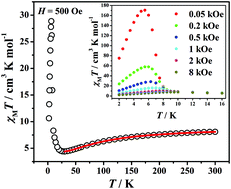
Inorg. Chem. Front., 2015,2, 403-408
https://doi.org/10.1039/C5QI00004A
About this collection
InorgChemFront is delighted to publish a collection of articles on “Molecular Magnetism”, guest edited by Hitoshi Miyasaka (Tohoku University) and Lapo Bogani (University of Oxford).
This themed collection will showcase recent important progresses on synthesis, theoretical investigations, property studies and potential applications of molecular-based magnets.